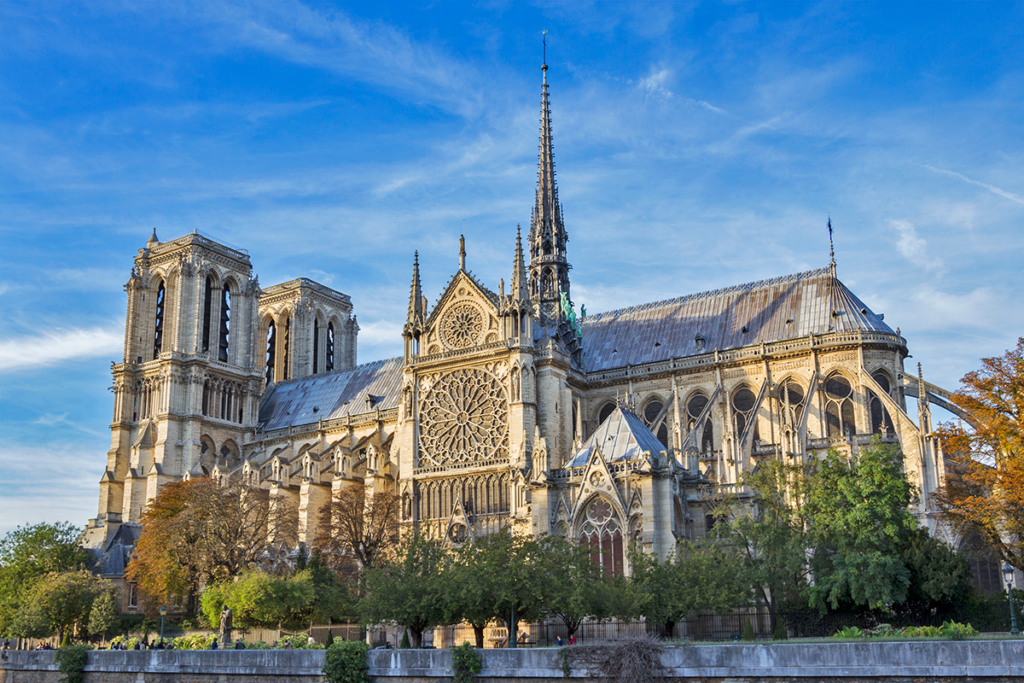This essay was originally a journal for the elective ART! Art as a Legionary Apostolate. Some editions were made in order to publish on this blog.

Sacred architecture was one of my main interests that led me to study an elective course of art as apostolate. If the goal is to use art as a tool for evangelization, liturgical art occupies a privileged place since liturgy is the source and summit of the life of the Church.[i] Within liturgical art, architecture of the sacred space where the community gathers to worship the Lord and be nourished by the sacraments, should occupy the first place in my reflection.
It is undeniable that when it comes to liturgical art, there is always a theological school behind the architectural design that wants to be emphasized.[ii] In his book The Way of Beauty, David Clayton explained that for Benedict XVI, the Gothic and Baroque can appropriately be called Catholic because both styles arise and develop as ideals of the Catholic faith.[iii] This relationship between theology and architecture brings us to one of the main themes around which discussion emerged in the weeks devoted to this topic: the evident opposition between churches in the modernist style and those that follow a traditional style. This difference in architectural styles is integral to the interpretation of the Second Vatican Council; what Benedict XVI calls a question of two opposing hermeneutics.[iv]

The problem with modernism, as an architectural style applied to the construction of Catholic churches, lies in its origin. Modernism seeks to break from the preceding historical tradition and relegates religious aspects to private life.[v] The philosophy and, even more, the theology behind this artistic movement was condemned by the Church as heretical.[vi] Nevertheless, even before Vatican II, in the later stages of the Liturgical Movement, and especially in some avant-garde authors, there was a tendency to experiment; even hiring architects who did not profess the Catholic faith like Le Corbusier “who made it very clear since the beginning that he was not a religious man”.[vii] We should ask: how can someone who has no faith build the house of faith? In Duncan Stroik’s book The Church Building as a Sacred Place, we learn that “Fr. Couturier […] argued that it was better to have a talented atheist designing churches than to have a pious artist who was mediocre. […] For Courtier, the church building was no longer to be seen as a teacher, minister, or evangelist, but rather as a space for functional assembly.”[viii]
After the Council, although Sacrosanctum Concilium calls for the preservation of sacred architecture and for sacred art to be ““set apart”, that is, distinct from everyday usage”,[ix] the hermeneutic of rupture gave rise to the destruction of architectural monuments that expressed a belief that for some theologians had already been overcome. According to Rose, in his book Ugly as Sin, modern liturgists and architects “claimed the spirit of Vatican II as their justification for the reformation of church architecture […] to legitimize the experimental church designs that the common people had consistently rejected.”[x] On the contrary, “Vatican II called for preservation of our churches”,[xi] not for its destruction. This destruction is the fruit of an evident hermeneutic of rupture; of “subjective opinion rooted in current architectural theories and innovative liturgical ideas that had never been officially adopted by the Catholic Church.”[xii] In 1971 the Holy See published the magisterial document Opera Artis to stop the architectural abuses in many places. However, the Lutheran architectural style of Edward Sövik, which emphasizes a non-Catholic theology, was taken as a model in various sectors. The opposition between “real presence,” sacrificial altar, a place for the Word of God, and the common priesthood of the faithful, versus the clerical hierarchy, is evident in the architectural experimentation and changes in churches in the 1970s and 1980s.
Even more influential than all the architectural changes seen during the modernist era, however, was the struggle between the conception of the Church as Domus Dei or Domus Ecclesiae.[xiii] Throughout the history of Catholicism, these two ecclesiological concepts have coexisted without problem. Nevertheless, twentieth-century “pseudo-liturgists” (an expression used by Ratzinger)[xiv] introduced this controversial division. For instance, churches having a round plan arose during this time but, unlike the Pantheon or the Palatine Chapel, they do not have the apse as a focal point. In many cases too, the altar was moved to the center of the nave, such that all the faithful could gather around it, and it is often located in a place lower than the rest of the liturgical furnishings. Effectively, iconoclasm also took place and even tabernacles were removed from many historic churches, or their central location was not considered when building new ones. These kind of design features were seen before only in Protestant churches and yet they were adopted into the panoply of Catholic church design.[xv]
However, it is necessary to clarify that this problem is not exclusively modernity, or even novelty, of Church architecture but rather it is the theology that it represents and whether it can express the ontological reality which is at stake.[xvi] For McNamara, the problem is not the new style or modernity itself, “but rather “un-liturgical-ness;” something that either fails to reveal, or which reveals less clearly, the nature of the liturgy.”[xvii] Although building a beautiful Church (in the ontological sense of the word) can be a significant economic investment, in many cases the problem is not a lack of money. This question needs to be addressed: How is it that many poor chapels in mission places look more like a church than some of the expensive cathedrals built by non-Catholic architects?
What is to be done? First, it is urgent to rediscover the authentic intentions for ecclesiastical architecture as outlined in the conciliar documents of the Second Vatican Council, that is, to go to the sources and to interpret them in light of the hermeneutic of continuity. Formation is indispensable, both in terms of the basic notion of sacred architecture and concerning the Theology of the Liturgy, for those overseeing the design or restoration of church architecture. Simply put, an inadequate “architectural theology” (a term coined by Michael Rose in his book Ugly as Sin) will result in an inadequate church. The sensus fidelium must be considered since many of the faithful will undoubtedly choose a Church that helps them to pray; whether by seeing its towers on the horizon from a distance and, in turn, for them to be willing to contribute financially.
Many of us complain about the growth of religious indifference; yet what can we expect if the public manifestation of faith through sacred buildings remains null and void by building churches that are impossible to recognize as such? One could continue to delve into the details, the various parts of the church and countless issues associated with them, but I think that in this short essay, I have exposed the essential principles to consider in restoring the sacred to ecclesiastical architecture.
[i] Cf. CONC. VAT. II, Sacrosanctum Concilium, no. 10
[ii] Cf. D. STROIK, The Church Building as a Sacred Place: Beauty, Transcendence, and the Eternal., Hillenbrand Books, Chicago / Mundelein 2012, pp. 10 – 11.
[iii] Cf. D CLAYTON, The Way of Beauty, Angelico Press, Kettering 2015, p. 173.
[iv] Cf. BENEDICT XVI, Christmas greetings to the Roman Curia, 22 December 2005.
[v] Cf. D. STROIK, The Church Building…, pp. 68, 71.
[vi] Cf. PIUS X, Pascendi Dominici Gregis; SACRED CONGREGATION OF THE HOLY OFFICE, Lamentabile sane exitu.
[vii] D. STROIK, The Church Building…, p. 71.
[viii] Ibid., p. 72.
[ix] D. MCNAMARA, Catholic Church Architecture and the Spirit of the Liturgy, Hillenbrand Books, Chicago / Mundelein 2009, p. 189.
[x] M. ROSE, Ugly as Sin: why they changed our churches from sacred places to meeting spaces and how we can change them back again, Sophia Institute Press, Manchester 2001, p. 137.
[xi] Ibid., p. 142.
[xii] Ibíd.
[xiii] Cf. D. STROIK, The Church Building…, p. 15.
[xiv] S. CHESSMAN, ”Klaus Gamber on the Orientation of the Roman Liturgy”, 2010, in https://sthughofcluny.org/2010/06/klaus-gamber-on-the-orientation-of-the-roman-liturgy.html (referenced on December 15, 2023)
[xv] Cf. D. STROIK, The Church Building…, p. 68.
[xvi] Cf. D CLAYTON, The Way…, p. 9; D. MCNAMARA, Catholic Church Architecture…, p. 192.
[xvii] D. MCNAMARA, Catholic Church Architecture…, p. 192.



